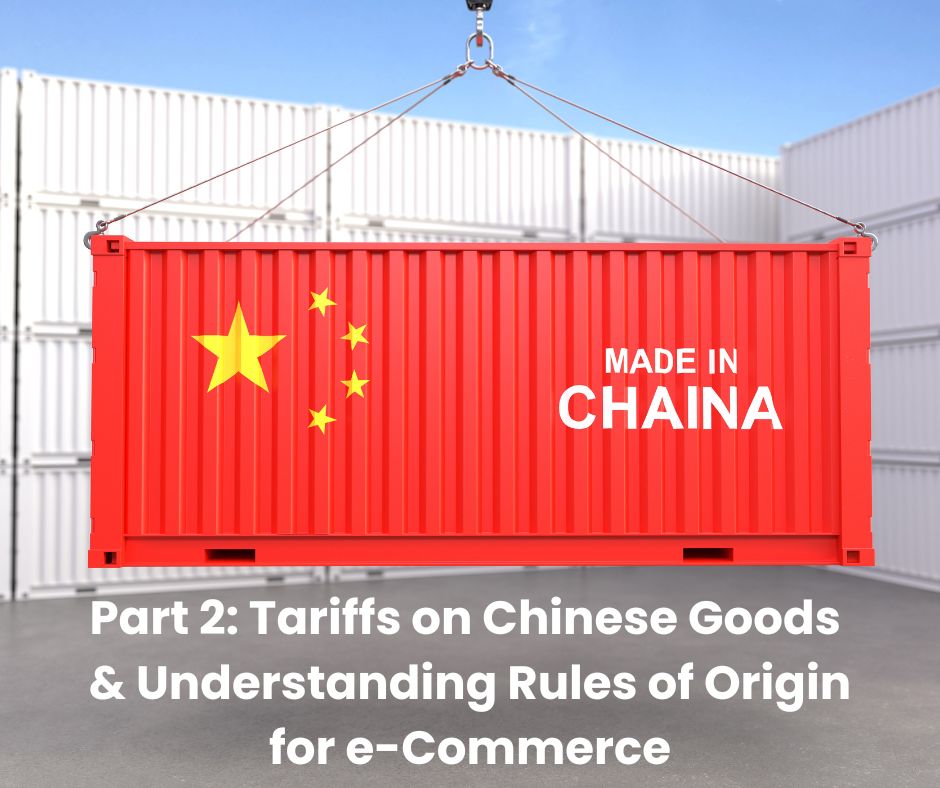Tariffs on Chinese Goods & Understanding Rules of Origin for e-Commerce

Part 2 of a 4-Part Deep Dive for Global Online Sellers.
As the global e-commerce landscape evolves, online sellers shipping to the U.S. must prepare for increasing complexity around tariffs — especially when sourcing from China. This article takes a closer look at how tariffs on Chinese goods are determined and why understanding Rules of Origin (RoO) is essential to protect your margins and stay compliant.
Tariffs on Chinese Goods: What’s Changing and Why It Matters
If your supply chain involves China — whether through direct sourcing or contract manufacturing — you need to understand that U.S. tariff policy has moved from broad trade negotiations to targeted enforcement. This means stricter scrutiny of the origin of goods, and in turn, higher costs if your products are flagged as Chinese-made.
Here’s What to Know:
· As of May 2, 2025, goods made in China, Hong Kong, and Macau will no longer benefit from the $800 de minimis exemption.
· Even low-value shipments will incur tariffs at the border, which can range from 10% to 145%, depending on the product category.
These tariffs apply regardless of where the shipment originates. That means a product made in China but shipped from Australia, Europe, or anywhere else will still be classified as Chinese-origin — and charged accordingly.
Key Implications for Sellers:
· Costs Rise Overnight: Once the de minimis exemption is removed for Chinese-origin goods, your unit economics shift dramatically. That $12 item you’ve been selling with tight margins add a 145% tariff.
· Customer Expectations Clash with Reality: If you're not charging tariffs upfront or educating your buyers, you could face delivery refusals, negative reviews, and lost business.
· Fulfillment Model Pressures: Direct-to-consumer (DTC) shipping from Asia becomes riskier, while domestic U.S. fulfillment grows more appealing.
Understanding Rules of Origin: The Gatekeeper of Tariff Liability
Rules of Origin (RoO) are how customs officials determine where your product was made. Not where it ships from, but where it was manufactured or substantially transformed.
These rules act like a passport for your product. If your item "carries" a Chinese passport, so to speak, it gets treated as Chinese at the U.S. border — no matter where it departed from.
Why RoO Matters for Online Sellers
RoO decide what tariff applies and whether you’re eligible for duty-free treatment.
If you're trying to avoid Chinese tariffs by routing goods through other countries, RoO will determine whether that strategy is valid — or just a costly workaround.
Understanding these rules helps you assess whether product modifications or supplier changes could shift your product’s origin status — and your duty liability.
Common Misconceptions Debunked:
“If I ship from Australia, the product becomes Australian.”
Not true. Origin is based on how the product was made, not where it ships from.
“If I relabel, repackage, or add a tag in another country, I’ve changed the origin.”
Customs doesn’t count cosmetic or superficial changes. The transformation must be substantial — meaning the product is essentially different from what it was before.
Real-World Application
Let’s say you import LED light parts from China, then fully assemble and program the final smart lighting product in Malaysia. If the transformation results in a new function, use, or classification under U.S. customs rules, the final product may be Malaysian-origin — potentially avoiding Chinese tariffs.
But if you’re simply bundling those parts or doing minor assembly elsewhere, your goods are still considered Chinese — and the tariffs follow.
Strategic Takeaway for Sellers
This isn’t just a compliance issue — it’s a business decision. Whether you need to adjust pricing, explore new suppliers, or consider re-engineering your product to change its origin, understanding how tariffs and RoO intersect gives you leverage.
Questions to Ask Your Supplier or Manufacturer:
· Where are all components sourced?
· What transformation occurs at each production step?
· Does the final product qualify for non-Chinese origin under U.S. RoO?
By proactively identifying risks and aligning with trustworthy partners, you’ll avoid nasty tariff surprises and stay ahead of shifting regulations.
Next in the Series:
Rules of Origin – What e-Commerce Sellers Need to Know for a country-specific look at how RoO applies in Australia and any country and how to ensure your goods qualify under U.S. trade rules.
Got questions or want help mapping out your product’s origin status? Join the Global Passports e-Commerce program or contact info@gtpalliance.com for tailored guidance.
Rules of Origin: What e-Commerce Sellers Need to Know When Shipping to the U.S.